You must be logged in to post a review.
Bavarian Cuirrasier – 1870
€68.00
Figure to assemble and paint
Ref.: 9 – PCA
Weight: 170 grs.
Material: White Metal
Number of Pieces: 17
Historical Review:
BAVARIAN CUIRASSIER– 1870. REF. 9 – PCA
The Bavarian Army or Royal Bavarian Army was the army of the electorate (1682-1806) and later the kingdom (1806-1919) of Bavaria. It existed from 1682 as the standing army of Bavaria until the merger of the military sovereignty (Wehrhoheit) of Bavaria with that of the German state in 1919. The Bavarian army was never comparable to the armies of the Great Powers of the 19th century, but it provided the Wittelsbach dynasty with sufficient scope for action, in the context of effective alliance policies, to transform Bavaria from a small, territorially disjointed state into the second largest state in the German Empire after Prussia.
The mobilisation of the army for the Austro-Prussian War of 1866 was not completed until 22 June, by which time the Prussian army was almost in Bohemia. The war went very badly for the Bavarians. The Bavarian commander-in-chief, Prince Karl, who also commanded the southern forces of the German Confederation, was rushing to the aid of the Kingdom of Hanover when he heard of the defeat of the Hanoverians at the Battle of Langensalza.
The Bavarian army’s difficulties were mainly attributed to the Bavarian Landtag (parliament) and the military leadership. Thanks to constant cuts in the military budget, the Bavarian War Ministry was not in a position to conduct manoeuvres above brigade level. Apart from Prince Karl and General von Thurn und Taxis, no Bavarian general had ever commanded a division. The newspapers also criticised von der Tann’s role.
When the candidacy for the Spanish throne of Leopold, Prince of Hohenzollern led to a worsening of relations between Prussia and France in 1870. Bavaria mobilised both army corps on 14 July. The two Bavarian army corps fought in the Franco-Prussian War as part of the 3rd Army under Crown Prince Friedrich Wilhelm (the 1st Army Corps under von der Tann, and the 2nd Army Corps under Jakob Freiherr von Hartmann). The Bavarians under the latter’s command stormed Wissembourg and took part in the Battles of Wörth, Beaumont, Sedan and the Siege of Paris. More than 5,000 Bavarian soldiers died during the Franco-Prussian War.
This cuirassier wore the breastplate for daily service, drill and manoeuvres, without the red felt inner lining. It was fastened with a narrow black leather belt. Although this cuirass did not provide protection against 1870s firearms, it was effective against edged weapons.
White leather cartridge-belt with black cartridge pouch. Glass water bottle with leather strap and metal holster. On the left side he carries a white canvas bag with leather clasp.
Underneath he wears a short light blue tunic with a single row of buttons. In cold weather the long jacket or waffenrock was worn. The collar was red, for the 1st Regiment, as was the piping on the cuffs, front edge and back flaps. Shoulder boards without white metal fringes bordered with red cloth.
The trousers of the Bavarian cavalry were heavily reinforced with black leather as protection against wear and tear. They were also light blue in colour and were trimmed with red piping. They were worn over the riding boots.
The steel helmet model 1842 had a conical-shaped neck guard. The brass cheeks were held in place by lion’s head rivets. On the left side, above the rivet, was the Bavarian cockade (white, light blue, white); the brass crest had a black horsehair crest, and the brass badge bore the monogram “L-II”.
He carries the straight sabre model 1826 – Pallash – with white leather buckle, steel scabbard hanging from the belt with white straps. The obsolete M1843 percussion pistol was kept in a leather holster on the front of the saddle. This model was replaced in 1872, by the Werder pistol model 1869. The saddle blanket was the same light blue colour as the uniform. It had rounded corners and piping and a red crown embroidered on the rear corners. Rump bag of the same colour with red piping, with the regimental number in the same colour. Natural brown leather saddle. In the front arch, the folded cape covers the holsters.

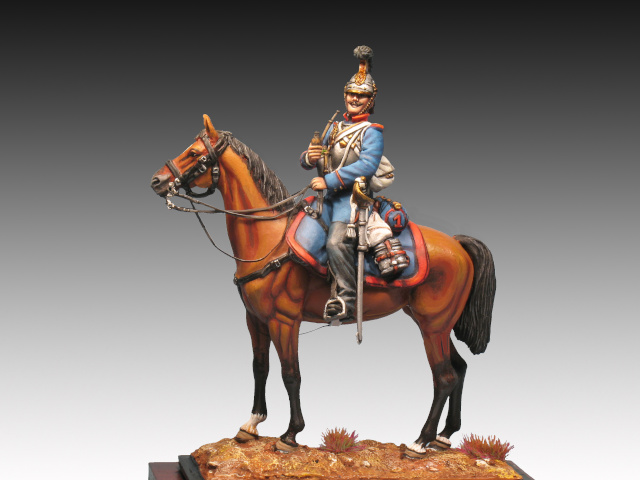
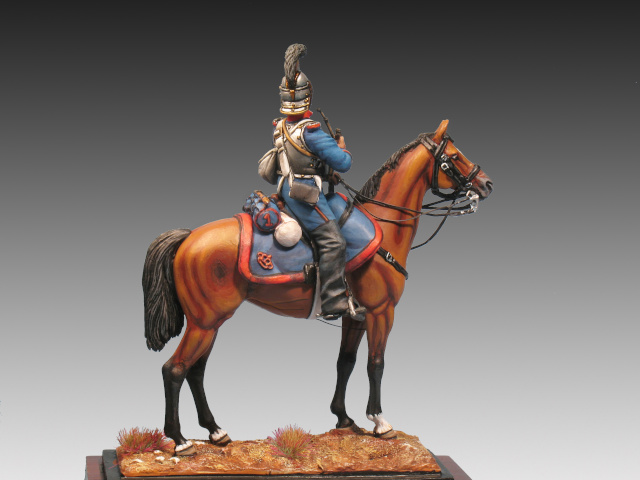


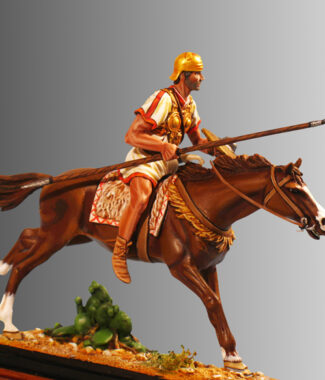
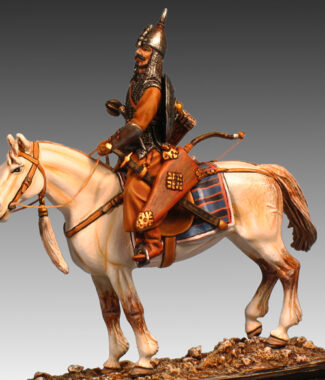
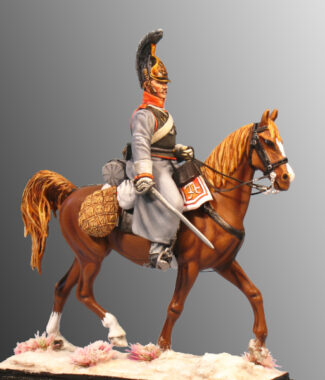
Reviews
There are no reviews yet.